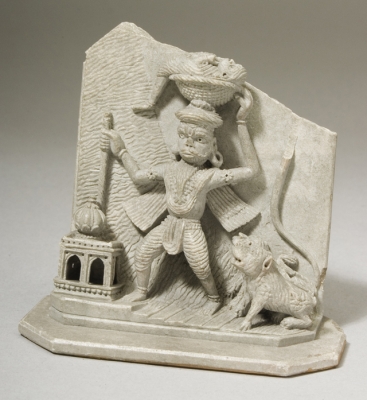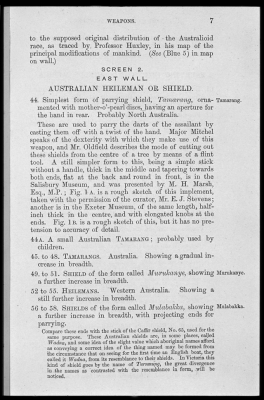To search the RPR site click here
Pitt-Rivers' series of objects, used in his displays and to illustrate his ideas
At the opening of his first public display of his collection, at Bethnal Green Museum in 1874 Pitt-Rivers explained that:
Since the year 1852 I have endeavoured to supply this want by selecting from amongst the commoner class of objects which have been brought to this country those which appeared to show connection of form. Whenever missing links have been found they have been added to the collection, and the result has been to establish, however imperfectly, sequence in several series.
Series were not an independent idea by Pitt-Rivers' but common as a scientific tool in the nineteenth century. As Hopwood, Schaffer and Secord put it:
"We would ... understand seriality as a range of practices, of the same order perhaps as those of standardization that pose a set of pervasive and prominent questions about continuity versus discontinuity, the play of difference through standardized objects, and the sequential display versus the array that could be seen at a glance.
For though serialization was often represented as an obvious response to matters of fact, it actually offered a technique for pressing a partisan claim that might be questioned, modified, rejected or ignored. By no means all science either embraced claims about series or depended on serial images and arguments. While developmental series were increasingly widely treated as self-evident frameworks for showing specimens and objects, many naturalists and physicians either vehemently denied the validity of unitary or parallel series or studiously avoided the problem altogether. Seriality was thus often a theme of polemic: traces, images and samples in graphic print or exhibitions were worked into arguments that produced or reinforced an experience of seriality in an audience; such dispositions and experiences could then be challenged or displaced.
...The notion of seriality seems especially apt in the age of revolutions, when series became central in fields ranging from zoology and political economy to periodical publication and newspaper journalism. The term was first adopted in English in the early seventeenth century for sequential disposition in time and space, such as in lists or catalogues, especially for valuable collections, notably of coins. But its sole technical use before 1800 was in mathematical analysis. Only in the nineteenth century was the word series used within specific sciences to describe the idiosyncratic arrangement and meaning of their objects: in accounts of entities such as strata and crystals from the 1820s, within statistics, palaeontology, chemistry and botany by the 1850s, and soon after in newer enterprises such as anthropology and analytic spectroscopy. The career of the French série is strikingly similar. First used in the mid-eighteenth century only in mathematics, it was not until the late 1700s that it was applied more generally to sequences of philosophical ideas, chemical substances and zoological entities. Série became a keyword in the visionary social and philosophical programmes of Charles Fourier and Auguste Comte. The German Reihe is older, in the sense of line and row, and the history of uses in the natural sciences less easily reconstructed, but only in the eighteenth century, it seems, did it begin to refer to temporal succession.' [2010: 252]
Pitt-Rivers used the term 'series' to designate a set of objects he considered to be connected by function, use or decoration which illustrated his belief that made things (as well as natural specimens) evolved from the simple to the complex. He therefore did employ series to show evolutionary progress but he allied it with his interest in typology. In essence he harnessed scientific idioms for his endeavours (as many others did at this time). See here for more information about Typology. In a general talk to Blackmore Museum in 1889-90 Pitt-Rivers explained what his series were:
The object as has already been explained is to trace the history of the Arts by means of specimens shewing links of improvement. Where the history of the Art or Invention is known, as in the case of those, which were introduced in historic times, the order of arrangement is comparatively easy. The only difficulty is in obtaining specimens of branch varieties or links of connection, which lasted only a short time, and then became obsolete. ... We should then be able to realise what the term "Evolution" really means, as applied to the Arts of life, and how closely analagous [sic] it is to the development of species, and varieties in Natural History. In both the stages of progression are equally slow and gradual. In both, varieties diverge and branch out in a tree-like form. Both are subject to the great law of the survival of the fittest, as revealed to mankind by the great genius of Darwin. In both we have the same difficulty of reconstructing the entire developmental series by the insertion of missing links. In both we have to distinguish forms which are homogenistic from those which are homoplastic. But here the analogy ends. The forms of nature beget and reproduce one another. Those of the Arts are merely the outward and visible signs of developments, that take place in the mind of Man; ideas embodied in material forms, so that they can be handled and arranged in sequence; but the study of them is essentially a psychological study.
In the case of pre-historic Arts, or the Arts of Savages, that have no written records, the only way is to collect specimens of the different varieties of the same Arts, such as tools, weapons, utensils of different kinds, ornamental patterns and so forth, and arrange them according to their affinities, guided by the analogy of known Arts and Sequences. But here we are met with a difficulty, which always entails caution in determining the order to be followed in the arrangement of the specimens. In the Arts as in all Nature, development and decay go hand in hand. Whilst as a rule we may be certain that the simpler forms preceded the more complex ones, on the other hand in the decay of any Art, or at a time when it is being superseded by other more useful contrivances, the older forms are liable to become scamped, less trouble is taken about them, and they degenerate into ruder shapes. There are also phases in which simplicity is the object sought for by the artisan, who has to eliminate extraneous complexity, that has been introduced at an earlier period of development, and found combersome. The only way in such cases is to notice the workmanship: as a rule the most advanced forms exhibit the best workmanship, as in the case of Flint Implements for example, ... and in which the skill, shown during the best periods, far exceeds what is seen, either in the decay, or in the infancy of the Art, and nearly all Art has its best period. Geological Sequence, and the Sequence of Artificial Deposits, also come in to determine the place of any objects found in them, as for instance in the case of Ramparts, or the silting of Ditches, which are very conclusive in determining Sequence, but very delusive as regards the duration of the periods on account of the great difference in the time, that the deposits take to accumulate. In short nearly every problem, which puzzles the Geologist or the Naturalist, also puzzles the scientific student of the Arts of life.
Reconstructing series: Working out the sequences of objects in series
It is likely that the four figures numbers written on many objects in the founding collection tell you roughly what position the object was put in the displays at Bethnal Green Museum or South Kensington Museum. They certainly are individually identified (occasionally groups of related objects are identified with one number together) and they certainly follow on from the numbers 1-1247 given in the 1874 catalogue of the Bethnal Green displays.
In the following web pages sets of information (and matching founding collection accession numbers) are provided based upon Alison Petch's work transcribing and matching to the 1874 published catalogue of the displays at Bethnal Green Museum
and
The 'Black Book' held by the Pitt Rivers Museum, a hand-written volume originally bound in black which lists 'Ethnological Series' starting with those also listed in the 1874 catalogue, but then going on to list some or all of the objects in the following series. The contents of the 'Objects illustrating the Animal Form Conventionalized in Ornamentation from different Countries' is set out in a document P141 handwritten on blue paper in the Salisbury and South Wiltshire Museum's Pitt Rivers papers. These are the only listings known for these series.
Here is a list of all the known series displayed in Pitt-Rivers displays at Bethnal Green Museum:
Accounts published in the 1874 catalogue:
Typical human skulls and hair of different races
Defensive Armour, shields
Body Armour
Head-dresses and Helmets from different localities
Boomerangs
Bird-headed picks, New Caledonia
Implements for accelerating the flight of the dart. Bows, crossbows and Quivers
Clubs
Paddles
Staves
Spears, javelins and arrows
Spuds
Spears with two or more points
Harpoons
Blades with an ogee section, double-skin bellows and ironwork
The axe, halbard, glaive and other cognate weapons
Blow-pipes
Morning stars, flails, holy-water sprinklers
Hand stones and slings
Knives, daggers and swords.
Said in the 1874 catalogue to be covered by the forthcoming Parts III and IV (but which were never published, and so far as is known were never written):
Modes of Navigation
Representative Arts of Savage and Early Races
Ornamentation
Personal Ornament
Pottery
Substitutes for pottery
Tools
Deities and religious emblems
Clothing and Weaving
Fire-arms (see below)
Illustrations of the modes of hafting stone implements
Prehistoric series: Natural forms, simulating artificial forms, forgeries and modern fabrications, palaeolithic implements, neolithic implements, bronze implements, iron implements, stone implements of modern savages adapted to the illustration of those of prehistoric times.
A comparison of the sorts of displays shown at Bethnal Green Museum, and described in the categories given above, and the display headings (and therefore series types) used at the Pitt Rivers Museum, Oxford is shown here. Note that not all the above series are listed in the Black Book so the objects that formed part of them are now missing.
It has not been possible to link together all the series that are known to have existed but some series are identifiable.
Here are links to pages that list the objects from the founding collection that can be matched to series:
Weapons Series listed in the 1874 catalogue (of Lane Fox's displays at Bethnal Green)
Other series outlined in the so-called Black Book
P141 S&SWM PR papers 'Objects illustrating animal forms ...
Forms of the Christian Cross series
Series in the Pitt Rivers Museum, Oxford in the 1920s
Here is a webpage about Pitt-Rivers and Typology.
Bibliography for this article
Hopwood, Nick, Simon Schaffer and Jim Secord 2010 'Seriality and Scientific objects in the Nineteenth Century' in 'Seriality and Scientific objects in the Nineteenth Century', History of Science vol 48, parts 3/4, No. 161 pp. 251-285
Fox, A.H. Lane 1877. Catalogue of the Anthropological Collection lent by Colonel Lane Fox for exhibition in the Bethnal Green branch of the South Kensington Museum June 1874 Parts I and II. London, Science and Art Department of the Committee of Council on Education HMSO [Re-issued 1879]
AP, November 2010, updated and matching objects links added March 2011.





